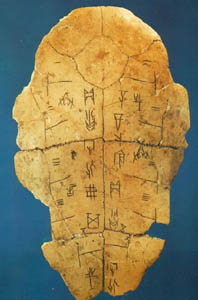Divine Tortoise (Shengui tu) [1]
Zhang Gui, Jin dynasty (1121-1234)
Handscroll, ink and color on silk, h: 26.5 cm, w: 53.3 cm
The invention of writing in the proper sense of the word is credited to Ts'ang Hieh, also called Shih 'Huang, the "Record Sovereign" because he is the protector and patron saint of history and archival documents. He is said to have lived in the twenty-eighth century B.C., and having ascended a mountain overlooking the river Loh, he saw a divine tortoise rising from the water. It exhibited on its back mysterious tracings of letters which "lay bare the permutations of nature to devise a system of written records," [2] -- a report which imputes that he saw the character of the five elements on the tortoise's back.
[1] This painting depicts a divine tortoise sprawling on the seashore, holding its head high and breathing out a current of air that forms a cloud. The red sun appears from behind the auspicious cloud. A vast expanse of water and sand dunes lie in the background, adding a sense of mystery to the picture. The tortoise is one of the four divine animals (siling) along with the legendary qilin unicorn, phoenix, and dragon. Combined with the white tiger, they constitute the five auspicious animals (wurui). The painting features elaborate and fine strokes. The cracks on the tortoise shell can be discerned. Its simple composition and beautiful color bear certain characteristics of the academic style of the Song dynasty (960-1279). It is the only extent work of Zhang Gui. At the top left of the painting is inscribed "Zhang Gui accompanies the emperor (Suijia zhang gui) ", under which two seals are affixed, one of them is "painting" (hua). Later collectors imprinted many other seals, including "heaven" (tian), "calendar " (li), "Treasured by Xiang Zijing's family (Xiang Zijing jia zhencang)". This painting was included in The Precious Collection of the Stone Moat: the First Edition (Shiqu baoji chubian), a catalogue of the Qianlong Emperor's calligraphy and painting collection.
[2] Mayer's Chinese Reader's Manual, p. 228, I, No. 756.
Invention of writing text from:
Paul Carus, Chinese Astrology. LaSalle, Open Court, 1907.
Ancient Chinese Oracle Shell (Tortoise), Anyang, Henan Province.
From Wikipedia: "The first indisputable examples of Chinese writing, dating back to the Shāng Dynasty in the latter half of the second millennium BCE, were found on oracle bones, primarily ox scapulae and turtle shells, originally used for divination. Characters were inscribed on the bones in order to frame a question; the bones were then heated over a fire and the resulting cracks were interpreted to determine the answer. Such characters are called 甲骨文 jiǎgǔwén "shell-bone script" or oracle bone script."
Evolution of Chinese writing from Oracle Bone stage to Modern Simplified style.
Chinese Stripe-Neck Turtle near the headwaters of Tiger River.




No comments:
Post a Comment